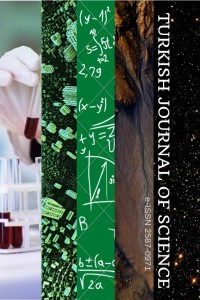Öz
The Grigorchuk group was first introduced by R. Grigorchuk in 1980. Also the Basilica group was introduced in 2002 by R. Grigorchuk and A. Zuk. In the following years, it was shown that these groups have deep connections with profinite group theory and complex dynamics. These groups have been proven to provide the self-similarity property, reflecting the fractalness of some limit objects associated with them. The Schreier graph codifies the intangible structure of a group. It establishes an equivalence relationship created by cosets. The Schreier graphs of the Grigorchuck group and the Basilica group are a combination of cycles arranged in a tree-like form due to the recursive expression of the generators of these groups. In this work, we study the Hosoya polynomial of these graphs and try to characterize them.
Anahtar Kelimeler
Basilica group Grigorchuk group Hosoya polynomial Schreier graph
Kaynakça
- [1] Bartholdi L, Grigorchuk R, Nekrashevych V. From fractal groups to fractal sets, in: “Fractals in Graz” (P. Grabner and W. Woess editors). Trends in Mathematics. Birkauser Verlag, Basel, 2003, 25 – 118.
- [2] Bartholdi L, Virag B. Amenability via random walks. Duke Math Journal. 130(1), 2005, 39 – 56.
- [3] Ceccherini-Silberstein T, Donno A, Iacono D. The Tutte polynomial of the Schreier graphs for the Grigorchuck group and the Basilica group. Ischia Group Theory. 2010, 2011, 45 – 68.
- [4] Deutsch E, Klavzar S. Computing Hosoya polynomials of graphs from primary subgraphs. MATCH Communications in Mathematical and in Computer Chemistry. 70(2), 2013, 627 – 644.
- [5] Deutsch E, Klavzar S. The Hosoya polynomial of distance-regular graphs. Discrete Applied Mathematics. 178, 2014, 153 – 156.
- [6] Grigorchuk R, Zuk A. On a torsion-free weakly branch group defined by a three-state automaton. International J. Algebra Comput. 12(1), 2002, 223 – 246.
- [7] Grigorchuk R. Solved and unsolved problems around one group, ınfinite groups: geometric, combinatorial and dynamical aspects. Progr. Math. 248, Birkhauser, Basel, 2005, 117 – 218.
- [8] Hosoya H. On some counting polynomials in chemistry. Discrete Applied Mathematics. 19(1–3), 1988, 239 – 257.
- [9] Nekrashevych V. Self-Similar Groups. Mathematical Surveys and Monographs, 117. American Mathematical Society, Providence, RI, 2005.
- [10] Şahin A, Şahin B. Hosoya polynomial of graphs belonging to twist knots. Turk. J. Math. Comput. Sci. 10, 2018, 38 – 42.
Öz
Kaynakça
- [1] Bartholdi L, Grigorchuk R, Nekrashevych V. From fractal groups to fractal sets, in: “Fractals in Graz” (P. Grabner and W. Woess editors). Trends in Mathematics. Birkauser Verlag, Basel, 2003, 25 – 118.
- [2] Bartholdi L, Virag B. Amenability via random walks. Duke Math Journal. 130(1), 2005, 39 – 56.
- [3] Ceccherini-Silberstein T, Donno A, Iacono D. The Tutte polynomial of the Schreier graphs for the Grigorchuck group and the Basilica group. Ischia Group Theory. 2010, 2011, 45 – 68.
- [4] Deutsch E, Klavzar S. Computing Hosoya polynomials of graphs from primary subgraphs. MATCH Communications in Mathematical and in Computer Chemistry. 70(2), 2013, 627 – 644.
- [5] Deutsch E, Klavzar S. The Hosoya polynomial of distance-regular graphs. Discrete Applied Mathematics. 178, 2014, 153 – 156.
- [6] Grigorchuk R, Zuk A. On a torsion-free weakly branch group defined by a three-state automaton. International J. Algebra Comput. 12(1), 2002, 223 – 246.
- [7] Grigorchuk R. Solved and unsolved problems around one group, ınfinite groups: geometric, combinatorial and dynamical aspects. Progr. Math. 248, Birkhauser, Basel, 2005, 117 – 218.
- [8] Hosoya H. On some counting polynomials in chemistry. Discrete Applied Mathematics. 19(1–3), 1988, 239 – 257.
- [9] Nekrashevych V. Self-Similar Groups. Mathematical Surveys and Monographs, 117. American Mathematical Society, Providence, RI, 2005.
- [10] Şahin A, Şahin B. Hosoya polynomial of graphs belonging to twist knots. Turk. J. Math. Comput. Sci. 10, 2018, 38 – 42.
Ayrıntılar
| Birincil Dil | İngilizce |
|---|---|
| Bölüm | Volume V Issue III 2020 |
| Yazarlar | |
| Yayımlanma Tarihi | 30 Aralık 2020 |
| Yayımlandığı Sayı | Yıl 2020 Cilt: 5 Sayı: 3 |


